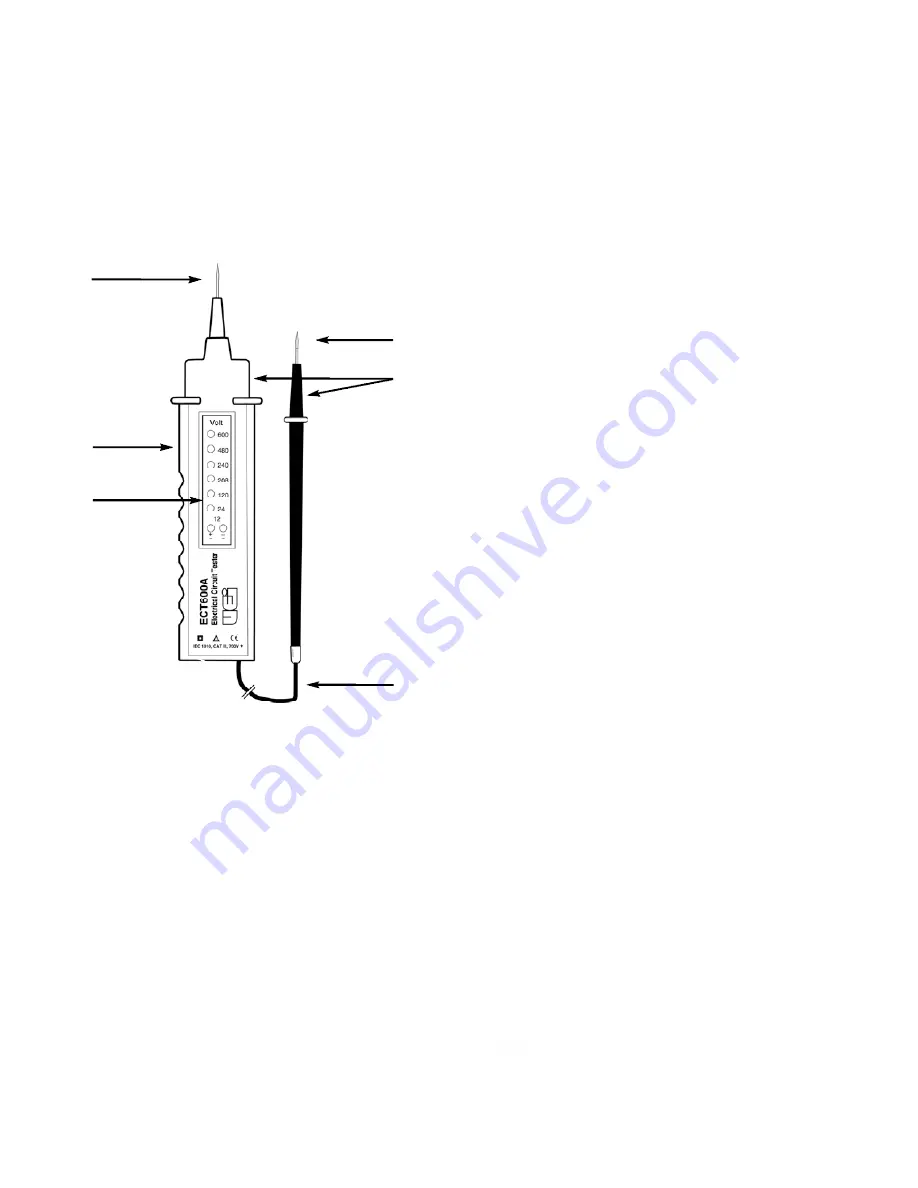
This does not indicate a problem with the instrument. To avoid tripping
a breaker, initially charge this instrument on a circuit with a 20 amp or
more breaker, without ground-fault isolation.
Your ECT600A will test both AC and DC voltage, ranging from
approximately 12 to 600 volts.
When AC voltage (up to 60 cycles) is detected, both of the bottom two
LEDs will light while a warbling audible tone sounds. When working
with both probes on AC voltage, the probes can be used on either the
hot wire or the return wire, without regard to polarity.
When DC voltage is detected only one of the bottom two LEDs will light.
That light corresponds to the polarity of the voltage at the probes. The
probe attached to the body of the instrument is the positive probe and the
probe at the end of the black test lead is the negative or “ground” probe.
Single Probe Quick Tests On Hot-Wires
Allow your instrument’s internal power supply to charge by testing
for voltage, leaving the unit exposed to the AC signal source for at
least 5 seconds.
After the unit is fully charged, you can detect AC voltages in excess of
100 volts by simply placing the body’s test probe in contact with a live
AC wire (without connecting the test lead probe). When contact is made
with a live wire, an audible tone will sound but no LED indicators will
light. This method is not recommended for determining that a wire is
safe to touch. If there is no reasonable option, be sure to verify the unit
is working as expected on a known voltage source.
Charging The Instrument
Allow your instrument’s internal power supply to charge by following
the procedures documented in “MEASURING VOLTAGE” steps 1 through
4, leaving the unit exposed to a voltage source (100 to 700 volts) for at
least 5 seconds.
Typically the instrument will retain its charge for at least 30 minutes
without being used, and will sustain the continuity tone for more than
one minute if recently charged.
Charging is required for all audio tone dependent functions.
Testing For Continuity
C o n t i n u i ty indicates that current can flow from one point to another. Yo u r
ECT600A will sound a tone when it senses less than approximately 900 K
Ohms between the two test probes. Although the volume and frequency of
this tone changes slightly with resistance, the instrument cannot “measure”
resistance. UEi makes numerous Digital Multimeters for this purpose.
1. Charge your instrument by placing the test probes in a wall outlet
for approximately 5 seconds.
2. Place the test probes at opposite ends of the circuit to be tested.
Ensure the probes are making good contact.
3. An audio tone sounds if a signal (voltage and current) can pass
between the two probed units.
CAUTION!
A p p roximately 1.5 Volts DC is present at the probe tips when the
instrument is fully charged. Some very sensitive electronic components,
( typically marked in a conspicuous manner), can be damaged by
low voltage s .
1.
Positive Probe
2.
Instrument Body
3.
Voltage Indicator Panel
4.
Negative Probe
5.
Probe Guards
6.
Test Leads
I n s t r u c t i o n s
Measuring Voltage
1. Remove the test lead from the storage clip on the back of
the instrument.
2. Place the test lead probe on one side of the circuit (i.e. ground
or neutral circuit).
3. Place the probe attached to the body on the other side of the
circuit (i.e. the hot circuit).
4. Observe indicated voltage and polarity (if applicable) on the
LED display.
NOTE:
The current surge produced when initially charging or
testing with this instrument may cause low amperage beakers and
ground-fault-isolation beakers to trip.
5
1
2
3
ECT600A-MAN
P. 2
4
6





